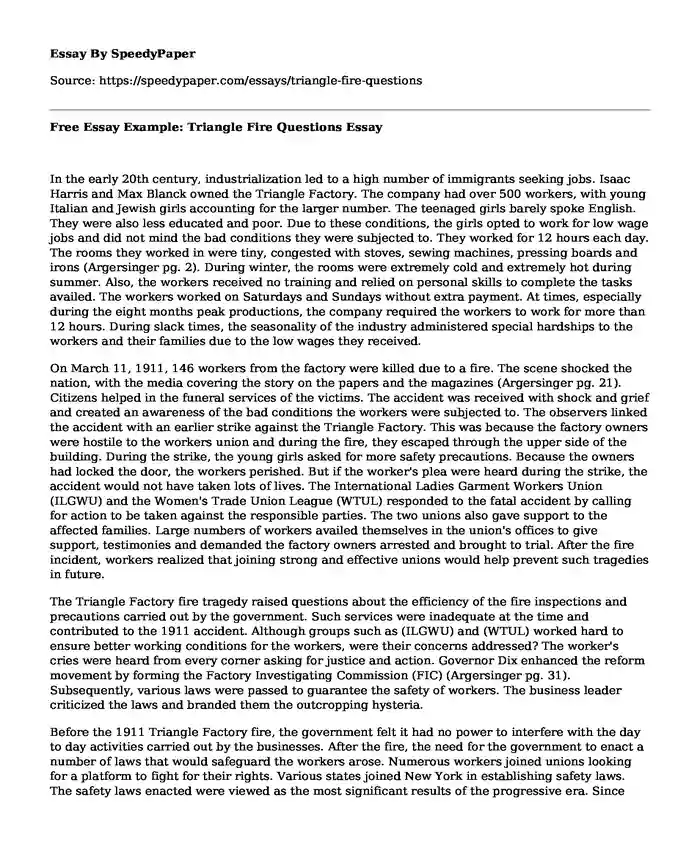In the early 20th century, industrialization led to a high number of immigrants seeking jobs. Isaac Harris and Max Blanck owned the Triangle Factory. The company had over 500 workers, with young Italian and Jewish girls accounting for the larger number. The teenaged girls barely spoke English. They were also less educated and poor. Due to these conditions, the girls opted to work for low wage jobs and did not mind the bad conditions they were subjected to. They worked for 12 hours each day. The rooms they worked in were tiny, congested with stoves, sewing machines, pressing boards and irons (Argersinger pg. 2). During winter, the rooms were extremely cold and extremely hot during summer. Also, the workers received no training and relied on personal skills to complete the tasks availed. The workers worked on Saturdays and Sundays without extra payment. At times, especially during the eight months peak productions, the company required the workers to work for more than 12 hours. During slack times, the seasonality of the industry administered special hardships to the workers and their families due to the low wages they received.
On March 11, 1911, 146 workers from the factory were killed due to a fire. The scene shocked the nation, with the media covering the story on the papers and the magazines (Argersinger pg. 21). Citizens helped in the funeral services of the victims. The accident was received with shock and grief and created an awareness of the bad conditions the workers were subjected to. The observers linked the accident with an earlier strike against the Triangle Factory. This was because the factory owners were hostile to the workers union and during the fire, they escaped through the upper side of the building. During the strike, the young girls asked for more safety precautions. Because the owners had locked the door, the workers perished. But if the worker's plea were heard during the strike, the accident would not have taken lots of lives. The International Ladies Garment Workers Union (ILGWU) and the Women's Trade Union League (WTUL) responded to the fatal accident by calling for action to be taken against the responsible parties. The two unions also gave support to the affected families. Large numbers of workers availed themselves in the union's offices to give support, testimonies and demanded the factory owners arrested and brought to trial. After the fire incident, workers realized that joining strong and effective unions would help prevent such tragedies in future.
The Triangle Factory fire tragedy raised questions about the efficiency of the fire inspections and precautions carried out by the government. Such services were inadequate at the time and contributed to the 1911 accident. Although groups such as (ILGWU) and (WTUL) worked hard to ensure better working conditions for the workers, were their concerns addressed? The worker's cries were heard from every corner asking for justice and action. Governor Dix enhanced the reform movement by forming the Factory Investigating Commission (FIC) (Argersinger pg. 31). Subsequently, various laws were passed to guarantee the safety of workers. The business leader criticized the laws and branded them the outcropping hysteria.
Before the 1911 Triangle Factory fire, the government felt it had no power to interfere with the day to day activities carried out by the businesses. After the fire, the need for the government to enact a number of laws that would safeguard the workers arose. Numerous workers joined unions looking for a platform to fight for their rights. Various states joined New York in establishing safety laws. The safety laws enacted were viewed as the most significant results of the progressive era. Since then, workers and employers in the United States work under defined laws, creating a conducive working environment. Although the fire took 146 lives, with it came the biggest industrial reforms. It changed the industrial life for good. Thus, it is regarded as "the fire that changed America."
Work Cited
Argersinger, Jo Ann E. The Triangle Fire. Bedford/St Martin's, 2009, pp. 2-120.
Cite this page
Free Essay Example: Triangle Fire Questions. (2022, Mar 14). Retrieved from https://speedypaper.net/essays/triangle-fire-questions
Request Removal
If you are the original author of this essay and no longer wish to have it published on the SpeedyPaper website, please click below to request its removal:
- The Internet as a Medical Support and Information Source, Essay Sample
- Free Essay with Q&A Concerning Organization Structure and Management
- Free Essay: How Social Media Is Influencing Politics in the USA
- Attitudes to Mental Illness, Free Research Paper Sample
- Gymnastic Sexual Assault in US, Essay Example for Everyone
- Essay Example: Customer Relationship Management and Enterprise Architecture
- When the Dancer Is Self - Alice Walker Essay Example
Popular categories





